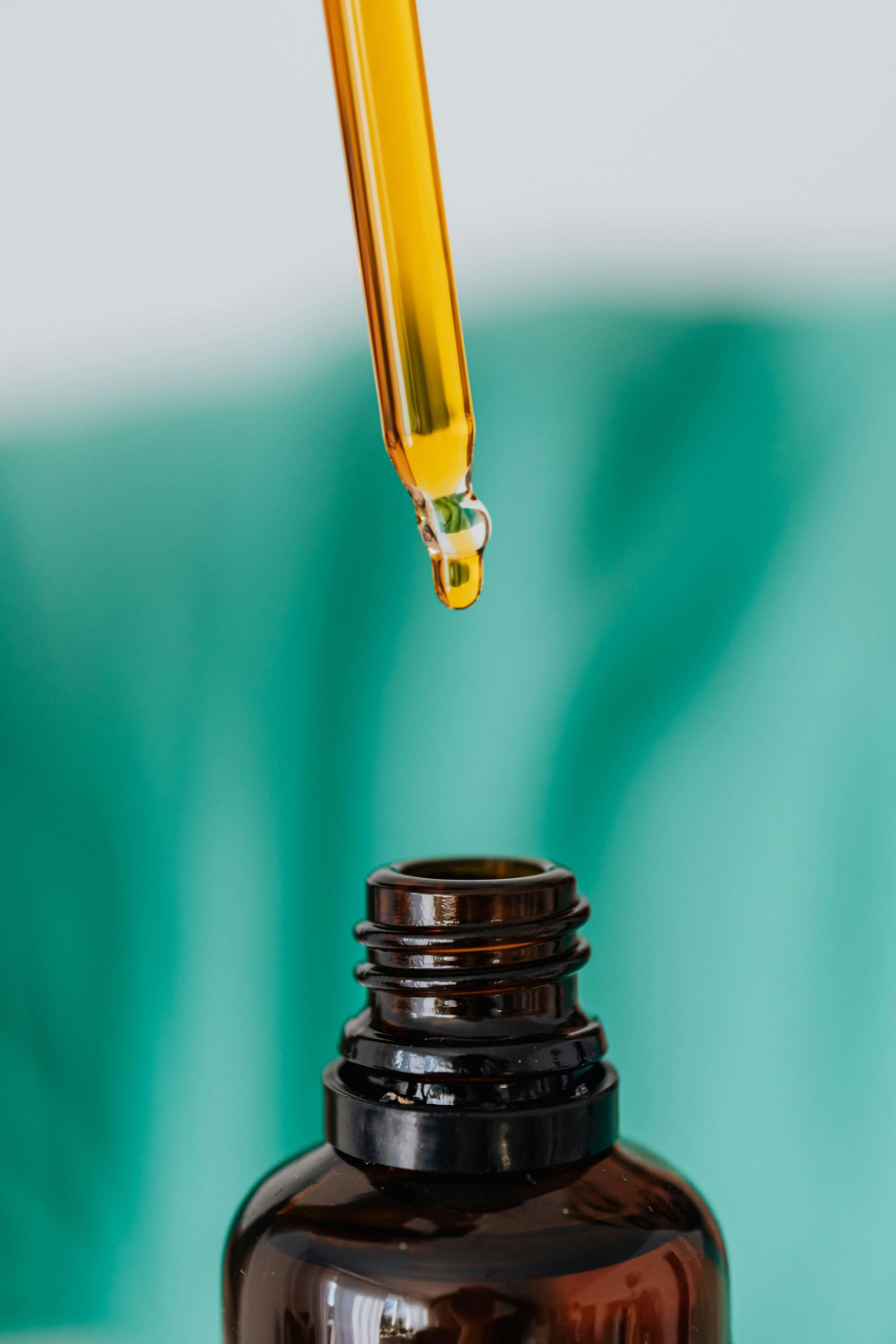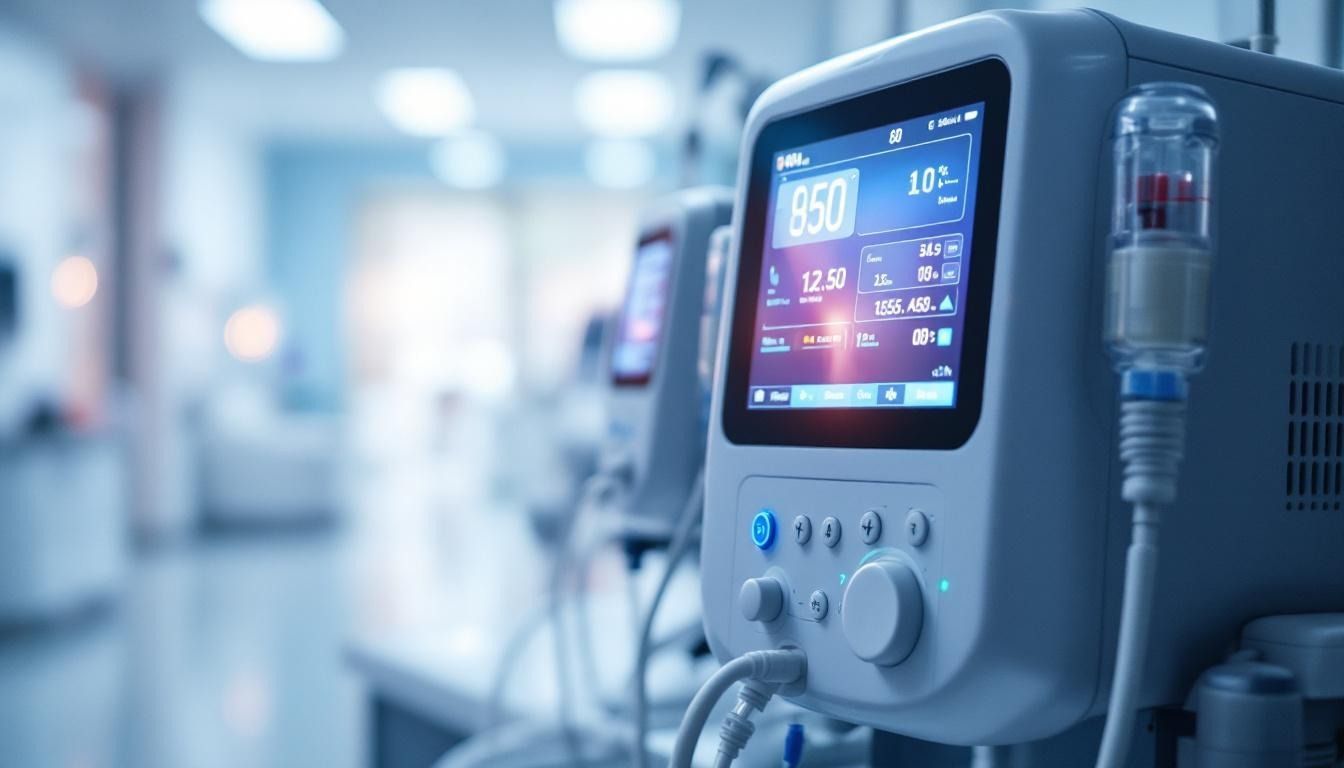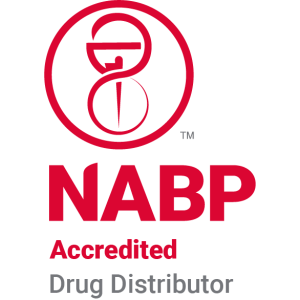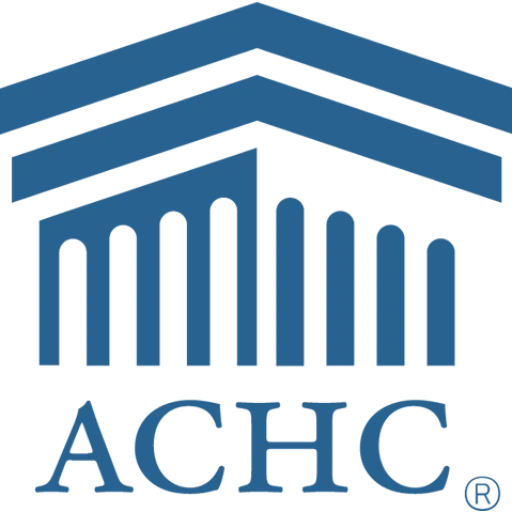Understanding the Importance of Fat in TPN Solutions for Nutritional Support
Introduction to TPN and Its Components
Total Parenteral Nutrition (TPN) is a life-sustaining method of providing nutrition intravenously to patients who cannot utilize traditional dietary routes due to medical conditions affecting the gastrointestinal tract. This approach bypasses the digestive system entirely, delivering essential nutrients directly into the bloodstream to ensure adequate nourishment and recovery. A key component in TPN solutions is fat, delivered through specialized lipid emulsions, which plays several critical roles essential for patient health and recovery.
The Essential Role of Lipids in TPN
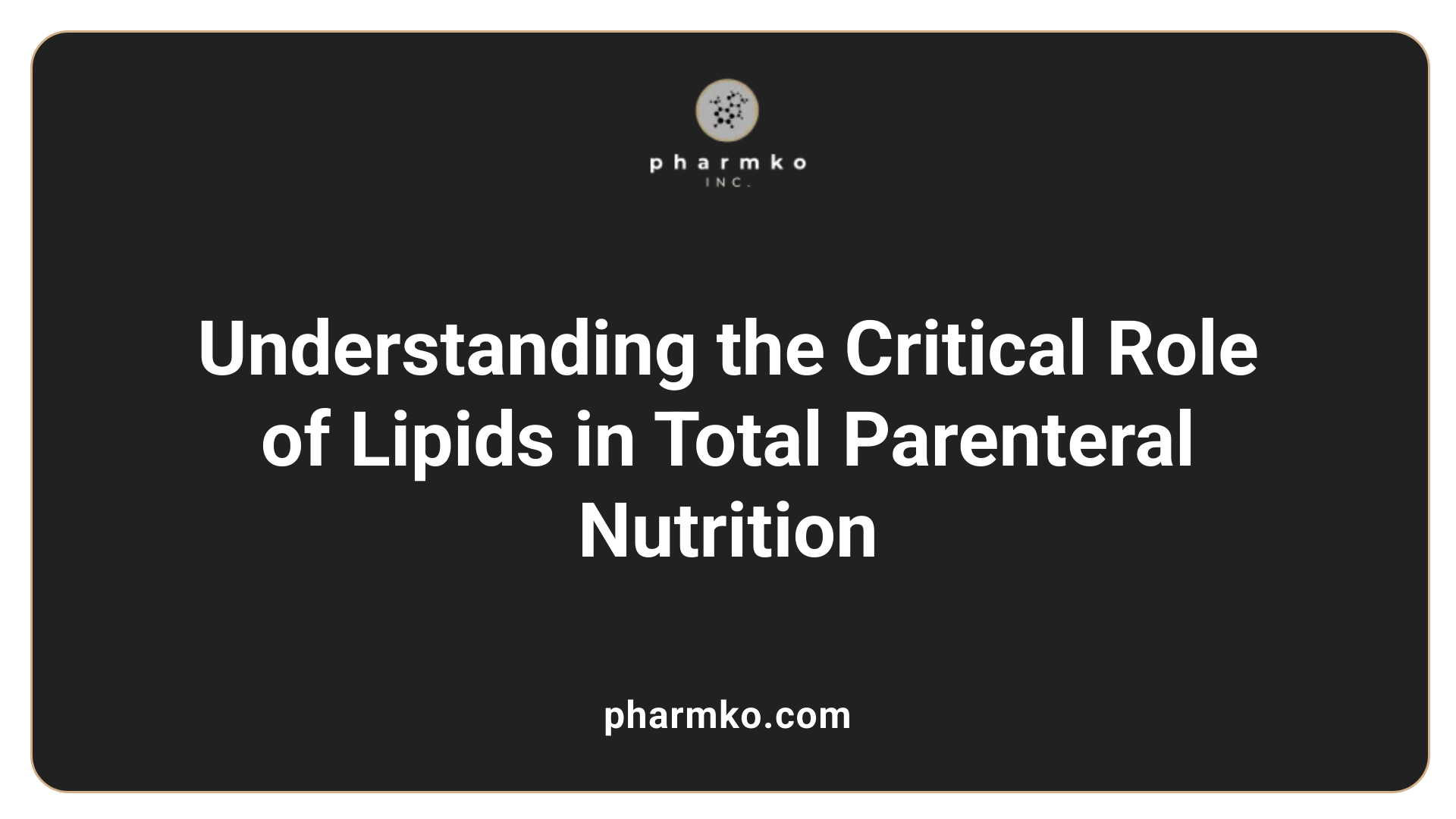
What is the purpose of lipids in Total Parenteral Nutrition (TPN)?
Lipids in Total Parenteral Nutrition (TPN) are crucial as they provide a concentrated source of calories and essential fatty acids. These components are vital for maintaining energy balance and supporting metabolic functions. Traditionally, soybean oil was the mainstay of lipid emulsions due to its high omega-6 content, particularly linoleic acid. However, over-reliance on soybean oil alone may not offer an optimal fatty acid profile. Thus, newer emulsions have emerged incorporating medium-chain triglycerides, olive oil, and fish oil.
The necessity of lipids for preventing fatty acid deficiency
The inclusion of lipids in TPN helps in preventing essential fatty acid deficiency, which can develop in patients if lipids are not provided promptly, typically within three weeks of IV nutrition. Ensuring adequate lipid intake helps maintain crucial bodily functions, such as hormone production and cellular integrity, and significantly reduces the risk of metabolic complications.
Energy provision through lipids
Lipid emulsions in TPN not only provide essential fatty acids but also serve as a primary energy source. On average, these emulsions should contribute 20-30% of total daily caloric intake. This is especially important for patients with high metabolic demands, as it allows sparing of protein use for energy and supports overall nutritional status. Recent advancements even include fish oil, known for its omega-3 fatty acids (DHA and EPA), recognized for their anti-inflammatory benefits and potential to improve clinical outcomes in patients receiving TPN.
Nutritional Composition and Variability in TPN
Macronutrient Composition in TPN
Total parenteral nutrition (TPN) is meticulously crafted to meet individual dietary needs, particularly for patients who cannot digest food. The macronutrient composition usually involves carbohydrates, proteins, and fats:
- Carbohydrates : Primarily sourced from dextrose, they typically contribute 60%-70% of total caloric intake.
- Proteins : Delivered as amino acids, proteins are crucial for tissue repair and metabolic processes.
- Fats : They provide essential fatty acids and concentrated calories, generally making up 20%-30% of daily caloric intake.
The Variety of Lipids Used in TPN
Lipids play an essential role in TPN. Traditional lipid emulsions, such as soybean oil, have evolved. Recent formulations include:
- Medium Chain Triglycerides (MCTs)
- Olive Oil
- Fish Oil These newer options can improve safety and enhance immune function while reducing inflammatory risks.
Tailoring TPN to Individual Needs
Customization of TPN is vital. Each regimen considers the patient’s specific health conditions, metabolic state, and laboratory results. Regular adjustments are made to ensure that the nutritional balance supports growth, healing, and overall wellness. This individualized approach helps to mitigate potential complications like refeeding syndrome and hyperglycemia.
| Component | Main Function | Typical Contribution to Calories |
|---|---|---|
| Carbohydrates | Provide immediate energy | 60%-70% |
| Proteins | Essential for tissue repair and immune function | Variable |
| Lipids | Concentrated energy, prevent fatty acid deficiency | 20%-30% |
Fat Emulsions and Their Benefits in Parenteral Nutrition
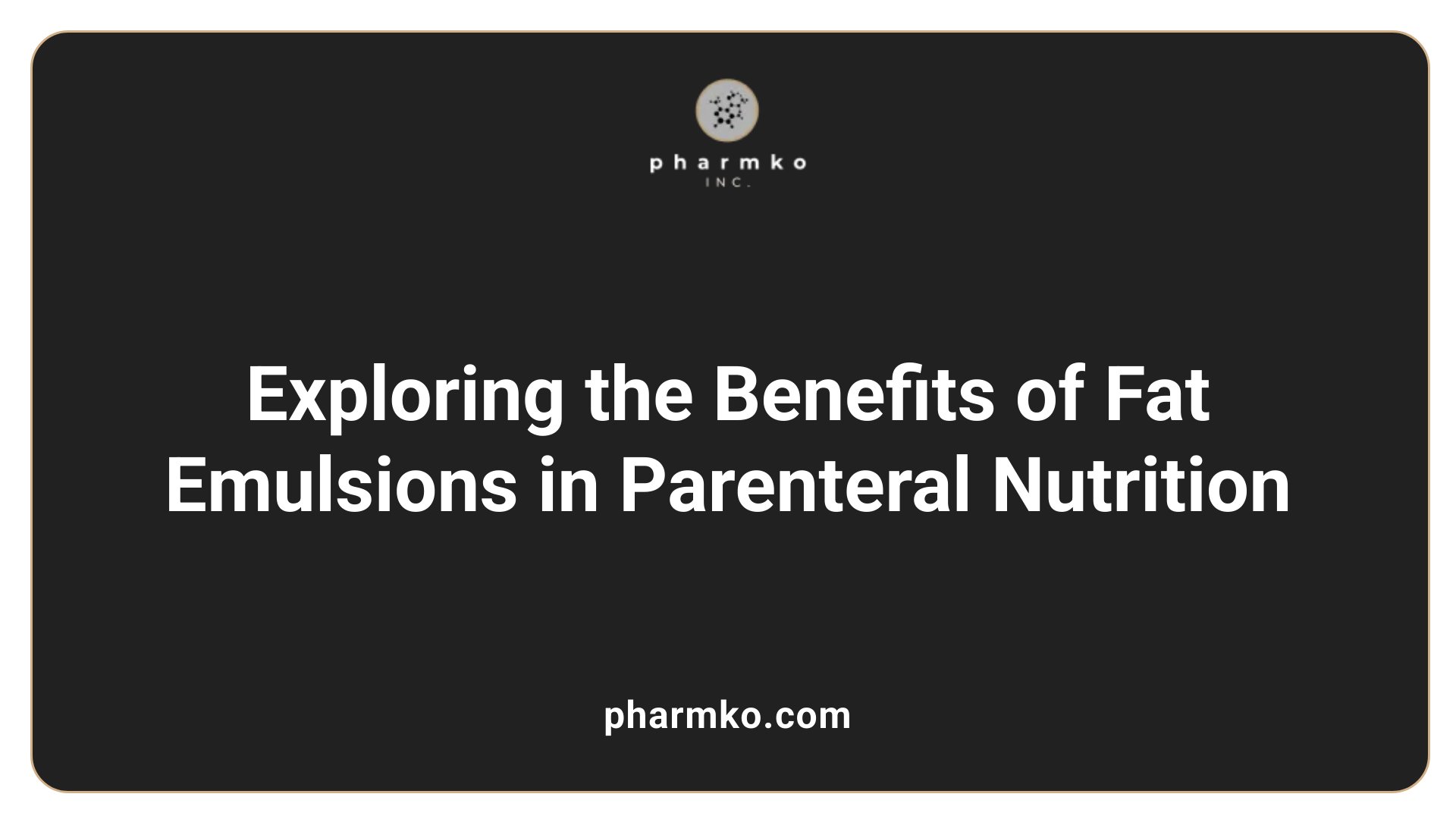
What are fat emulsions used for in parenteral nutrition?
Fat emulsions in parenteral nutrition (PN) are essential for delivering necessary nutrients to patients who cannot obtain adequate dietary fat due to medical conditions. These emulsions provide a concentrated source of energy, preventing deficiencies in essential fatty acids. They are administered through an intravenous (IV) catheter under professional supervision, allowing healthcare providers to monitor for side effects, such as parenteral nutrition-associated liver disease or allergic reactions.
Types of lipid emulsions used in PN
Various lipid emulsions are used in PN, each designed to enhance patient outcomes. Traditional soybean oil-based emulsions have been widely used. However, recent innovations include mixed-oil emulsions incorporating medium-chain triglycerides (MCT), olive oil, and fish oil, which may offer anti-inflammatory properties and better metabolic outcomes.
| Type of Lipid Emulsion | Primary Source | Benefits |
|---|---|---|
| Soybean Oil | Soybean oil | Stable, widely used; requires monitoring for omega-6 overload |
| MCTs | Coconut oil | Easily digestible; quick energy source |
| Olive Oil | Olive oil | Antioxidant properties; supports immune function |
| Fish Oil | Fish | High omega-3 content; anti-inflammatory effects |
Impact on patient outcomes
The incorporation of fat emulsions in PN significantly improves patient outcomes. Studies have shown that using mixed-lipid emulsions can reduce hospital stays and lower infection rates. For critically ill patients, balanced lipid profiles facilitate optimal energy delivery and metabolic support, aiding recovery and reducing complications associated with excessive glucose intake.
Potential Complications of Omitting Lipids in TPN
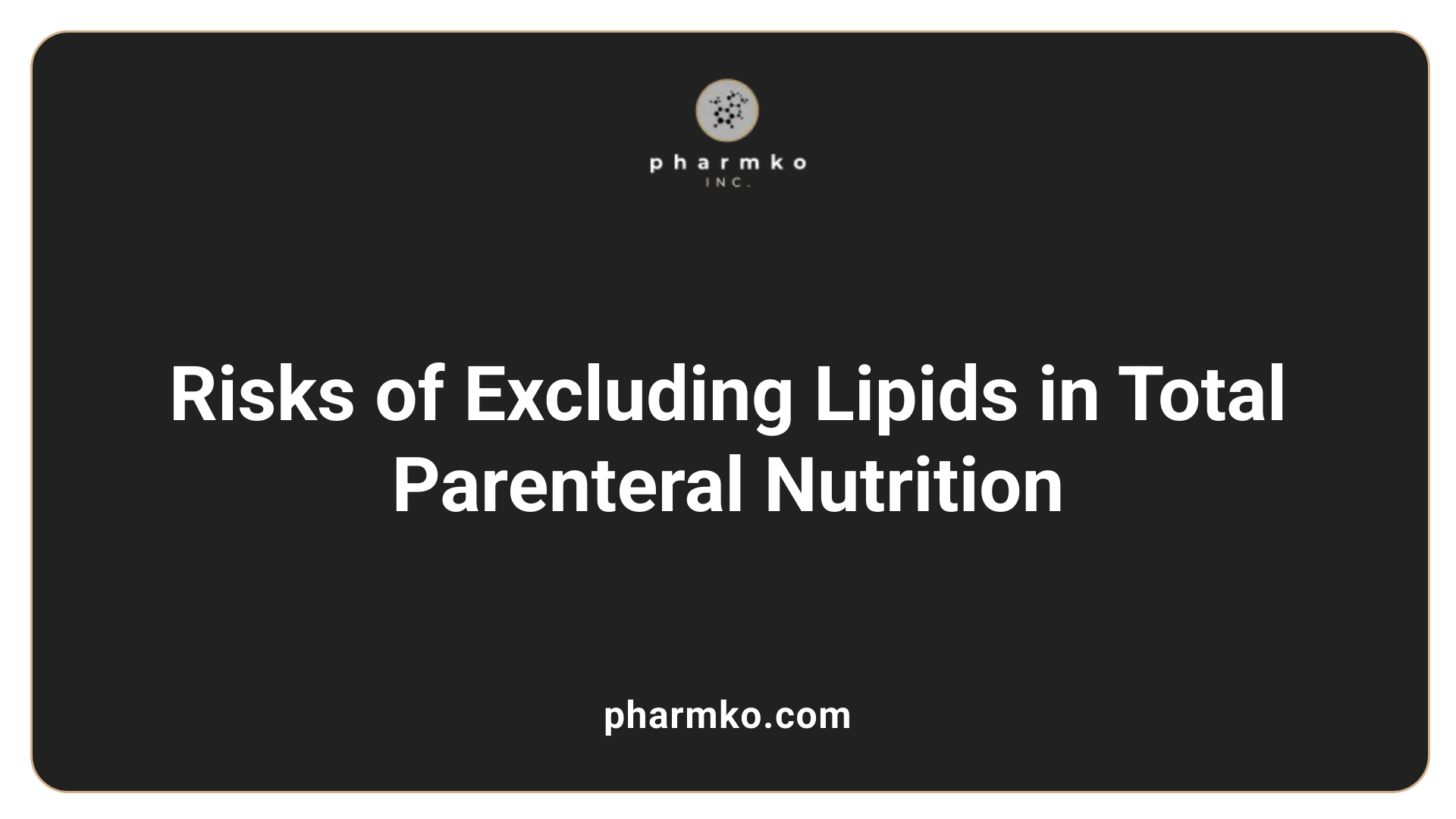
Risks of Excluding Lipids in TPN
Excluding lipids from Total Parenteral Nutrition (TPN) treatment is risky and not commonly recommended. Lipids are vital for providing essential fatty acids and a concentrated source of calories. Without these fat components, patients are at heightened risk of malnutrition. This is particularly concerning for patients who rely solely on TPN to satisfy their nutritional requirements due to gastrointestinal dysfunction.
Consequences of Lipid Deficiencies
The absence of lipids can result in essential fatty acid deficiency, which may develop in as little as three weeks. This deficiency leads to metabolic complications such as impaired immune function, growth delays, and potential liver toxicity from improper nutrient balance. Additionally, patients may experience symptoms like dermatitis and an increased susceptibility to infections, reflecting the importance of lipids in maintaining overall health.
Monitoring and Addressing Deficiencies
For patients receiving lipid-free TPN, close monitoring is crucial. Regular assessments of metabolic status and provision of alternative fatty acid sources should be considered. Ongoing blood work enables healthcare providers to identify and address emerging deficiencies swiftly, ensuring that individual nutritional needs are met adequately. Adjusting TPN formulations to include lipids can significantly improve outcomes and mitigate risks associated with nutritional deficiencies.
Advancements in Lipid Emulsion Formulations
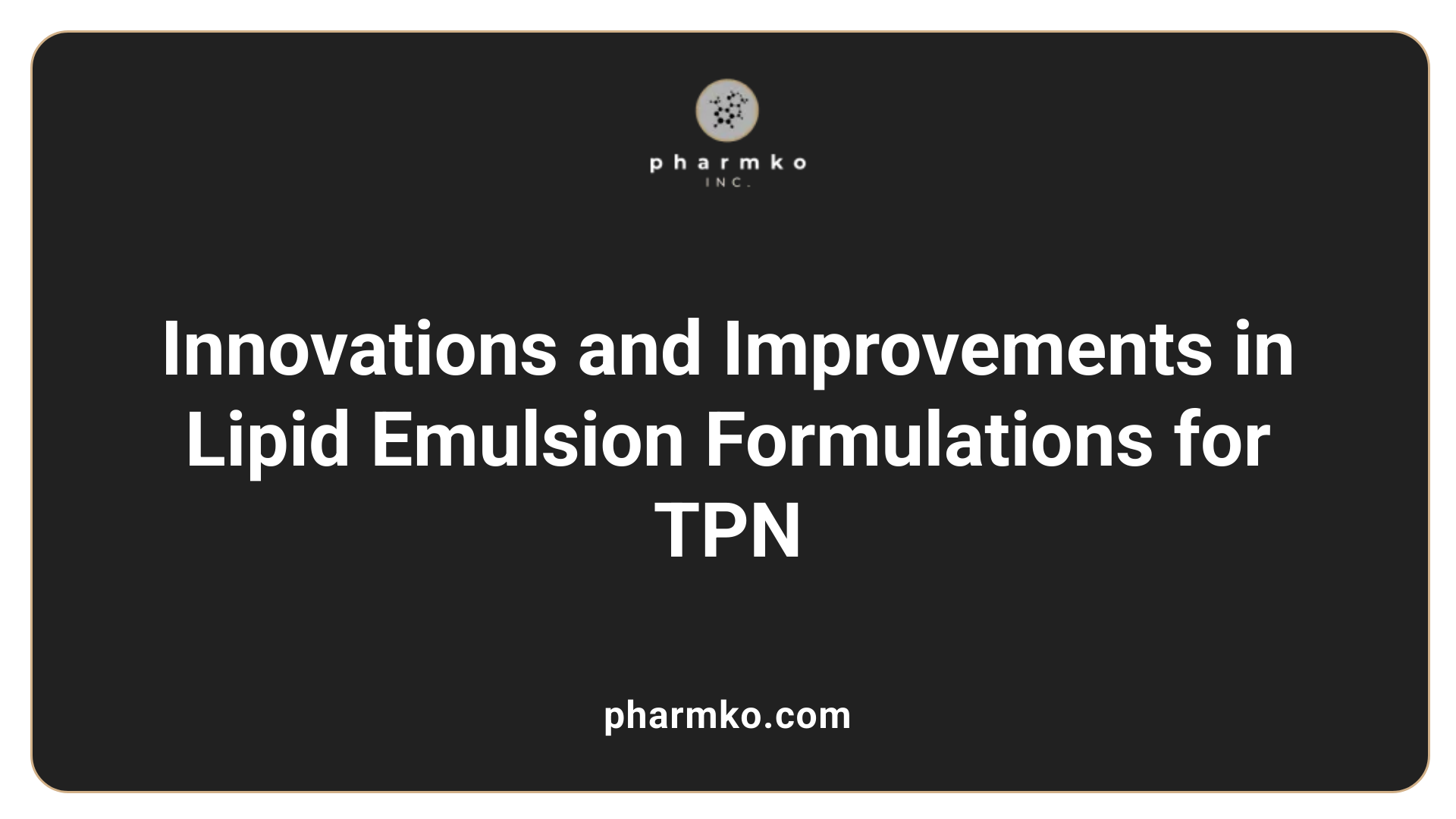
Introduction and Benefits of New Lipid Formulations
Recent advancements in lipid emulsions for Total Parenteral Nutrition (TPN) have significantly transformed nutritional support. These new formulations not only deliver essential fatty acids and calories but also offer clinical benefits, particularly for patients unable to obtain nutrition via the gastrointestinal tract.
Shift from Traditional Soybean Oil
Historically, soybean oil-based emulsions were the standard in TPN formulations. However, recent years have seen a shift towards newer products incorporating various oil combinations such as olive oil, safflower oil, and fish oil. These alternatives may enhance immune function, reduce infection risks, and provide antioxidant properties, promoting overall better health outcomes in patients.
Role of Modern Lipid Emulsions in Improving Outcomes
The incorporation of mixed-lipid emulsions, including medium chain triglycerides (MCT) and fish oil, has been shown to modulate inflammatory responses and potentially lower complications associated with traditional lipid sources. Studies indicate that patients receiving these advanced formulations experience shorter hospital stays and lower infection rates, highlighting a tangible improvement in patient care. This evolution emphasizes the importance of individualized nutrition strategies in optimizing TPN outcomes.
Understanding and Managing TPN Complications
Common Complications of TPN
Total parenteral nutrition (TPN) can lead to several complications, most notably metabolic abnormalities and infections. Common metabolic issues include hyperglycemia, particularly if fat emulsions complicate glucose control. Refeeding syndrome is another significant concern for severely malnourished patients resuming feeding. Infections can arise from catheter-related complications, such as bloodstream infections or thrombophlebitis.
Strategies to Mitigate Risks
To reduce the risks associated with TPN, clinicians must employ rigorous aseptic techniques during administration. Additionally, nutritional formulations should be individually tailored, addressing specific patient needs based on regular blood work. Limiting lipid emulsions to 1-1.5 g/kg body weight daily can help prevent metabolic disturbances like hypertriglyceridemia and cholestasis. Monitoring essential fatty acids is essential to avoid deficiencies, which can occur without proper formulation.
Monitoring and Management of Metabolic Disorders
Regular monitoring of glucose levels and metabolic state is paramount during TPN therapy. Adjustments to nutrient compositions based on patient responses can help manage complications effectively. Assessing electrolytes and trace elements is also critical to address deficiencies or imbalances that may occur over time. Maintaining a close collaboration among healthcare providers ensures timely interventions to optimize patient outcomes.
The Interplay of Nutrition and Immunity with Lipid Use in TPN
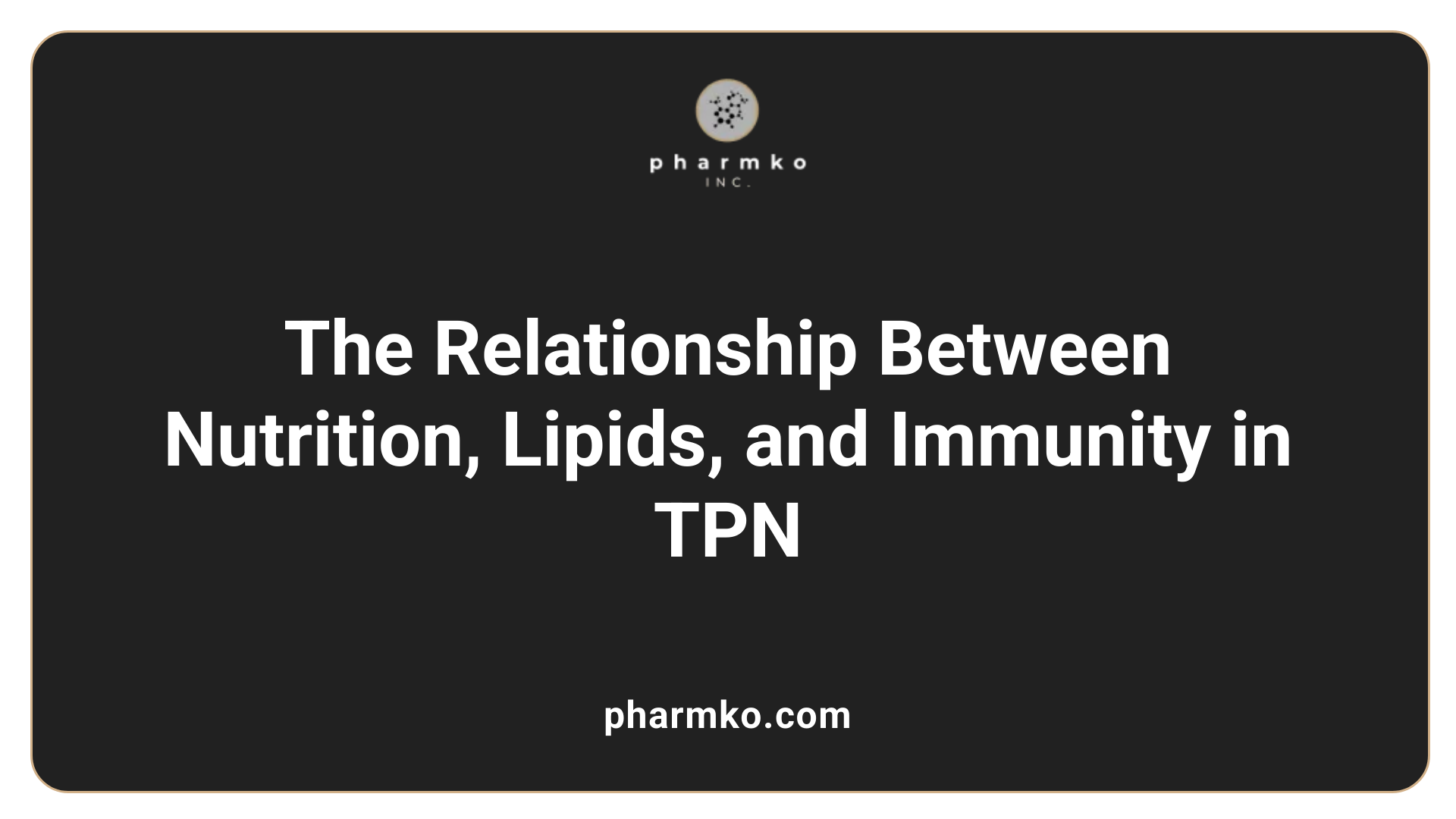
Influence of lipids on immune function
Lipids play a critical role in Total Parenteral Nutrition (TPN), not just by providing calories but also by supporting immune function. Certain lipid emulsions, such as olive oil-based formulations, have been associated with enhanced immune responses and a reduced risk of infections. This is particularly important for critically ill patients who require optimal nutritional support to maintain their immune defenses.
Lipid emulsions and inflammation
The choice of lipid emulsions can influence inflammation levels within the body. Traditional soybean oil emulsions, while effective, can promote inflammatory responses due to their high omega-6 fatty acid content. In contrast, newer mixed lipid formulations that include medium-chain triglycerides, olive oil, and fish oil are designed to modulate inflammatory processes, enhancing the overall efficacy of TPN in managing inflammatory conditions.
Clinical benefits of specific lipid types
Recent studies, such as those from Duke University Medical Center, have shown that children receiving mixed-lipid emulsions experience shorter hospital stays and fewer infections compared to those on soybean oil alone. Tailoring lipid use in TPN can lead to significant clinical benefits, highlighting the importance of individualized nutrition for improving patient outcomes.
Guidelines and Clinical Practices for TPN Administration
Clinical guidelines in TPN
Total Parenteral Nutrition (TPN) serves as a life-saving intervention for patients who cannot feed orally. Clinical guidelines emphasize the need for personalized nutrition plans based on individual patient needs, metabolic conditions, and laboratory results. TPN solutions are typically prepared by specialized pharmacies to avoid contamination and ensure accurate nutrient composition. Given the risks like refeeding syndrome and hyperglycemia, healthcare providers must closely monitor patients receiving TPN for any metabolic abnormalities.
Lipid dosage recommendations
When formulating TPN, lipids play a crucial role, usually contributing 20%-30% of total caloric intake. It is generally advised to limit lipid intake to 1 g/kg body weight per day to prevent complications such as hypertriglyceridemia or fat overload syndrome. New lipid emulsions, including those based on olive or fish oil, may offer clinical benefits by modulating inflammation and nutrient absorption.
Patient-specific considerations
Careful consideration during TPN administration involves assessing the patient's specific health circumstances, including their gastrointestinal status, metabolic demands, and potential for infections. Adjustments to the lipid and macronutrient ratios may be required to address individual deficits, especially in critically ill patients. The administration route—central or peripheral—depends on the osmolarity of the TPN solution, ensuring minimal complications like thrombosis.
The Role of Lipids in Pediatric TPN
Importance of lipids in pediatric nutrition
Lipids are a crucial component of Total Parenteral Nutrition (TPN) for pediatric patients, providing essential fatty acids and concentrated energy. They help prevent deficiencies that can occur in children unable to absorb nutrients via the gastrointestinal tract. In pediatric TPN, lipid emulsions typically account for 20-30% of total caloric intake, ensuring sufficient energy while minimizing reliance on carbohydrates, which can be a contributing factor to hyperglycemia.
Challenges in pediatric TPN administration
Administering TPN to children brings unique challenges. Due to their smaller body size and varied nutritional needs, careful tailoring of lipid content is essential to prevent complications such as fat overload syndrome. The choice of lipid emulsion is also vital; newer mixed oil formulations may provide clinical benefits, yet they require thorough evaluation to confirm their efficacy compared to traditional soybean oil emulsions.
Monitoring growth and development with TPN
Continuous monitoring is necessary to assess the growth and development of pediatric patients on TPN. Regular lab work is conducted to adjust the lipid and overall nutrient composition based on individual requirements. This tailored approach helps ensure that growth milestones are met, and potential deficiency-related health issues are promptly addressed. Regular assessment helps clinicians balance the benefits of TPN with its associated risks, promoting overall health in these vulnerable patients.
Optimizing Patient Outcomes with Nutritional Support Via TPN
Maximizing the benefits of TPN with lipids
Lipids are an essential component of Total Parenteral Nutrition (TPN), providing critical calories and preventing fatty acid deficiencies. They contribute 20% to 30% of daily caloric intake, serving not only as an energy source but also as a means to support immune function. Modern TPN formulations have evolved beyond traditional soybean oil-based emulsions to include mixed oils like olive, safflower, and fish oil, which have demonstrated clinical benefits including reduced infection rates and improved liver health. Careful selection and monitoring of lipid components can enhance patient outcomes while minimizing the risk of adverse effects.
Patient assessment and tailored nutrition
Each patient's TPN needs should be customized based on their metabolic status, underlying health conditions, and physiological requirements. Regular assessments and lab work are essential to adjust macronutrient ratios, particularly carbohydrates, proteins, and fats, to prevent complications such as refeeding syndrome and metabolic imbalances. A tailored approach ensures that patients receive the necessary nutrients for recovery, especially for critically ill individuals with heightened energy needs.
Long-term management and monitoring
Long-term TPN management requires vigilant monitoring to prevent complications such as hyperglycemia and liver disease. Adjustments in nutritional formulations may be needed over time, particularly if a patient's condition changes. Clinicians must follow strict aseptic techniques during TPN administration to mitigate infection risks. Continuous evaluation of lipid profiles and metabolic indicators is crucial to optimize therapeutic outcomes and provide comprehensive care for patients on TPN.
Comprehensive Nutritional Solutions: Future Directions for TPN
What does nutritional support with TPN entail?
Nutritional support with Total Parenteral Nutrition (TPN) involves delivering all necessary macronutrients and micronutrients intravenously to patients who cannot meet their nutritional needs through oral or enteral means, typically due to intestinal failure.
TPN solutions are usually provided in All-in-One (AIO) or multi-chamber bags. These bags contain carbohydrates (primarily glucose), amino acids for nitrogen, and lipids for essential fatty acids. The formulation is highly individualized based on the patient's unique nutritional requirements and medical background.
Monitoring plays a critical role in TPN management. Regular assessments cover the patient's electrolytes, blood glucose levels, and fluid balance, aiming to prevent complications such as hyperglycemia or refeeding syndrome. More importantly, patients receiving TPN typically undergo evaluations that include anthropometric, biochemical, and clinical measures to assess their overall nutritional status.
Education for patients and caregivers on managing feeds and maintaining sterile techniques is crucial, as this contributes significantly to the success of long-term TPN usage.
Innovations in TPN solutions
Research in lipid emulsions and their effects on inflammation and immune responses is ongoing. Mixed lipid emulsions that incorporate olive oil, fish oil, and medium-chain triglycerides (MCT) are being investigated to enhance TPN's clinical effectiveness.
Role of research and development
The development of new formulations aims to minimize complications arising from traditional soybean oil-based emulsions, which have pro-inflammatory properties. Continued research is critical to identify optimal lipid ratios and combinations for diverse patient populations, particularly in pediatric care.
Potential improvements in clinical nutrition
Future advancements might focus on refining TPN compositions to better address specific metabolic demands, improve liver health, reduce infection risk, and enhance overall patient outcomes. Evaluating the impact of individualized TPN solutions on recovery times and healthcare costs will be essential components of future research efforts.
Conclusion: The Vital Role of Fats in TPN for Patient Health
Understanding the significance of fats within Total Parenteral Nutrition is crucial for optimizing the health and recovery of patients reliant on intravenous nutritional support. Fats not only deliver essential energy and support metabolic functions but also prevent deficiencies and contribute to improved clinical outcomes through their influence on immunity and inflammation. As TPN practices continue to evolve, innovations in lipid formulations promise further improvements in safety and efficacy, highlighting the importance of tailored nutrition strategies for the diverse needs of patients. In ensuring adequate nutritional support, the inclusion and management of fats within TPN remain a cornerstone of patient care.
References
- Total Parenteral Nutrition - StatPearls - NCBI Bookshelf
- TPN and Lipids: Nourishing the Body Beyond Energy
- Parenteral Nutrition Overview - PMC - PubMed Central
- Components of Total Parenteral Nutrition Solutions
- [PDF] The Hitchhiker's Guide to Parenteral Nutrition Management for Adult ...
- Parenteral Nutrition: What it Is, Uses & Types - Cleveland Clinic
- What is in a TPN Solution? - AmeriPharma® Specialty Care
- [PDF] Total Parenteral Nutrition: Home Care Guide - Northwestern Medicine



